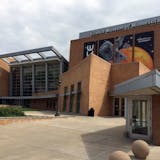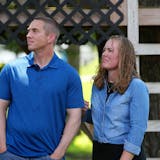Catholic Charities Twin Cities has added temporary fencing around its Dorothy Day Place campus in downtown St. Paul due to increased safety issues.
In late July, the organization added 6-foot-tall chain-link fences around parts of its buildings — the third consecutive year the nonprofit has installed temporary fencing during the summer as well as during other times during the pandemic, said Keith Kozerski, Catholic Charities’ chief program officer.
The organization is designing up to 6-foot-tall metal fencing that could be installed by late 2025 as a permanent solution, but until then, Kozerski said the chain-link fencing will remain up through at least the end of this summer.
The campus, which has emergency shelters, permanent housing and a resource center, draws more than 1,000 Minnesotans a day. With homelessness increasing across Minnesota and with more documented mental health issues and opioid use, Kozerski said the nonprofit had observed rising numbers of assaults, overdoses and other safety issues.
He said the organization has to balance controlling access to the campus, which is located in a prominent downtown gateway near the Xcel Energy Center, with not stigmatizing homelessness. Although, Kozerski said, U.S. Bank Stadium in Minneapolis, for instance, has installed 6-foot temporary chain-link fencing, and started replacing it with permanent 8-foot fencing for safety.
“Aesthetics are important to us; we want to be an inviting place for people to come. But we do want to make sure that we’re able to provide a safe environment,” Kozerski said, adding that Catholic Charities also hosts neighborhood safety meetings. “We take our responsibility to our guests, but also to our neighbors, very seriously.“
Catholic Charities opened the $100 million project in downtown St. Paul in 2019 and homelessness has increased since then. From2022 to 2023, Catholic Charities saw a nearly 40% spike in the number of people seeking help.
“The individuals served in our facilities are part of our community ... they’re our most vulnerable neighbors,” Kozerski said.



